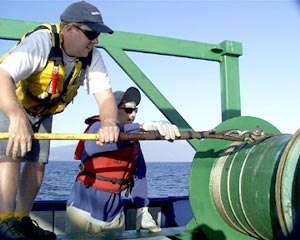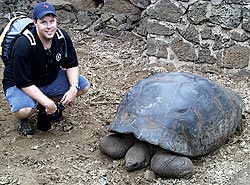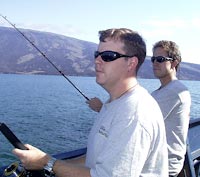Galápagos Islands
Expedition 5:
Aug 23-Sep 24, 2001
Mission & Objectives
Daily Updates
Mail Buoy
Scientists & Crew
Interviews
Hot Topics
Slideshows
Videos
Activities
Glossary
|
Interviews: Geologist Paul Johnson
 Paul and Dan Fornari carefully guide the tow fish wire around the drum as they reel in the MR1 sonar fish. Paul and Dan Fornari carefully guide the tow fish wire around the drum as they reel in the MR1 sonar fish.
In 1994, Paul Johnson was mapping the seafloor around White
Island Volcano, New Zealand, from a fishing boat. After Paul and his
team were done with the mapping, they jumped in the water dressed
in wetsuits and SCUBA gear and dove 180 feet to do by hand what is
normally the job of a robotic arm. With gloves on to protect his fingers,
Paul reached out with a jar to catch a sample of the hydrothermal
gases around the volcano. “We were doing the work by hand because
it was so shallow,” Paul says. “Our dives ranged in depth
from 180 feet to about two feet up higher on the slope of the volcano.”
 |
 |
| While visiting Santa Cruz, Paul meets one of the giant tortoises that live at the Charles Darwin Research Station. |
Although
the water coming out of the vents was extremely hot, an inch away
from the vents the water would be cool again. The Bay of Plenty kept
the divers cool and comfortable and the volcano supported tons of
sea life. “We saw fish and lobsters everywhere and sometimes
a couple of sharks.”
During that trip Paul and his colleagues examined the interior of
the volcano’s crater. “We walked up into the crater, past
bubbling hot water springs and boiling mud pits and saw a boiling
green central lake.” The magma underground was cooking the ground
above it. “I thought it was awesome. In Hawaii you get kind of
used to hiking on lava flows and looking at lava lakes. It was neat
to look at the regional geology of White Island.”
 |
 |
| Paul is in charge of processing the sidescan sonar data from MR1 into beautiful maps of the seafloor. They are essential to our research program and selecting sampling and camera tow targets. |
Paul
grew up in Massachusetts as a tuba player. In high school he played
in a quartets and quintets, giving performances in front of crowds
of people. His parents still live in Holden, Mass., and his sister,
Anna, and her family live in Norfolk, Mass. Paul was accepted into
the University of Massachusetts as a performance major. But within
a week he was having second thoughts. “The number of jobs openings
for tuba players wasn't real high.” He experimented with engineering
and then learned about geology. Looking for something different, he
transfered to the University of Hawaii, in Honolulu. “It sounded
exotic, warm and it has volcanoes. At the time I didn't know I was
going to stay there forever.” He first worked in NASA’s Space
Grant program to create an identification key for rocks seen through
a video camera. This was part of NASA’s remote sensing program, so
during remote operations involving landing on different planets a
rover could drive over the terrain and the images sent back to Earth
could be interpreted accurately. “When NASA sends a remotely
operated vehicle to Mars, they need to know what kind of rocks they
are driving across. It was an up-close-and-personal key to rocks that
I helped develp,” Paul says. Now, he is more familiar with looking
at rocks 3,000 meters underwater.
 |
 |
|
Paul and Todd Ericksen take time out to fish the waters off of Fernandina. |
 |
After
graduating from college in 1992, Paul took half a year off to travel
and do research. He mapped the seafloor around Easter Island to study
the regional tectonics in the area for his graduate work. He then
did field work in Saipan, near Guam and backpacked through French
Polynesia across Tahiti, Borabora and Huahime. He returned to Easter
Island twice more that year between trips to Chile and Mexico. “I’ve
gotten to know Easter Island really well.”
The tools he used to study Easter Island are similar to the ones he
uses today for his job at the Hawaii Mapping Research Group as a sea
floor mapper and data processor. His job has taken him all over the
world. “The most frustrating thing about going to sea on a research
expedition is being surrounded by water and never being able to go
in it.” An avid underwater photographer, Paul SCUBA dives or snorkels
whenever he has the chance at port or at home in Honolulu. “Hawaii
is a wonderful place to live, because you have the ocean year round,
day after day.” |

 Paul and Dan Fornari carefully guide the tow fish wire around the drum as they reel in the MR1 sonar fish.
Paul and Dan Fornari carefully guide the tow fish wire around the drum as they reel in the MR1 sonar fish. 

